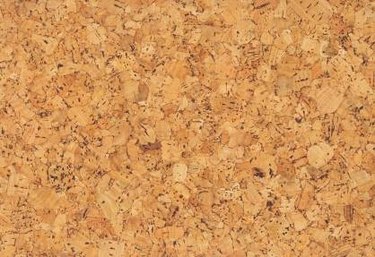
Corkboard is made of cork, Quercus (oak) suber (cork). Cork is a type of bark (suberose parenchyma) that can be harvested from a live cork oak tree in a sustainable way. Peeling the bark off the cork oak tree does not damage or kill the tree. Cork tree bark can be harvested off a single tree for as long as 200 years. The first time bark is harvested is when a tree reaches 20-35 years old. After the bark is peeled the tree will regenerate its bark. It is able to be reharvested every 9-10 years.
Features
Video of the Day
Because cork has a number of unique features, and it is sustainable, it is enjoying renewed interest and being used in a growing number of products and ways. According to We Cork, cork was used to help insulate cold storage rooms. Insulation corkboard is composed of cork granules that have expanded during a manufacturing process. Insulation cork is still being made today and it comes in many different forms that include sheets and blocks.
Video of the Day
Properties
According to Douglas Hardwood Floors, cork is harvested primarily from the Mediterranean countries of Portugal and Spain. The bark is composed of millions of individual cells in a lattice-like structure with gas filled pockets. These properties give the bark resilience, elasticity, the ability to regain shape, thermal insulating and acoustic dampening properties, and shock absorption.
Uses
Corkboard is used in flooring, in the insulation of flooring, in furniture, and on walls. Granulated forms are used in larger insulation applications. Smaller corkboard chunks are used in the bottling of wine. Mounted sheets of corkboard are used to retain notes above desks. Small disks of cork are used to absorb moisture as coasters. Corkboard is used in shoes to absorb moisture and provide shock absorption. Corkboard is used to dampen sound. It is also valued for its ability to float (such as on fishing lines) and it finds uses in craft projects.
Cork Taint
Problems with cork have occurred, particularly with the wine industry and an issue called cork taint. According to George Taber, commenting in an 2007, Eleanor and Ray Heald article for Appellation America, "Hans Tanner noticed (Portuguese) workers boiling batches of corks in caldrons of chlorinated water to bleach them and suspected that this caused the TCA problem." He goes on to talk about how the taint problem has affected the taste of wine and the wine industry. George Taber is an expert on wine cork closures.
Considerations
Some of the challenges with cork flooring include frequent maintenance and some difficulties in cleaning. In addition, if it is scuffed or gouged, that spot will open the floor to easy staining because the cork is porous. As its popularity continues to grow its price is growing too. However,cork is still one of nature's wonder products.